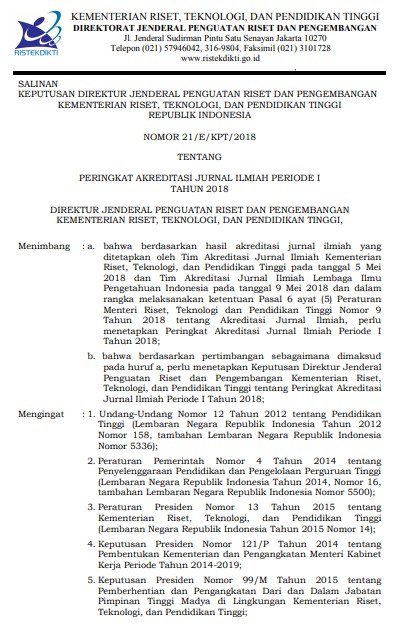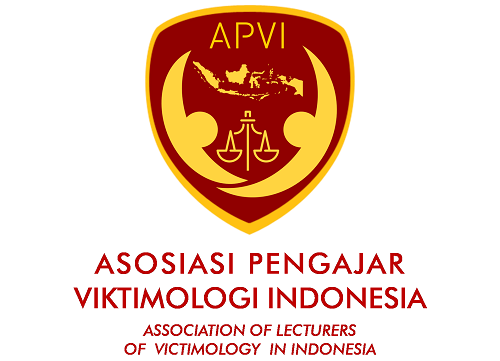SUSTAINED CHARACTER BUILDING THROUGH LITERATURE FOR COLLEGE STUDENTS IN INDONESIA
Abstract
This article aims at promoting sustained character building through literature especially for college students in Indonesia. Till present, the character building has been restricted to the embedment of good virtues to children and adolescents. The majority of existing studies and researches, therefore, tend to focus their attention on such limited area. Character building ought to be a sustainable effort halted not when one finishes his/her study at elementary or intermediate grades. It should be maintained all life long. There are two highlighted problems which are going to explore in this paper: first, why literature is still considered to be one of the effective media to establish sustained character building for college students and second, what appropriate Instructional Strategies to conduct such effort are. The result shows that literature is still effective due to its natural characteristics, its wide spectrum, and its dynamically broadened functions. Under the conviction that the students have already been undergoing the process of embedment of some core values before, the given literary works containing, elaborating and questioning or challenging the given embedded values are taken to be the source of discussion. The instructional strategies cover discussion, debate, seminar, film appreciation, and creative writing.
Keywords: character building, instructional strategies, literature, sustained
Full Text:
PDF View
References
Abrams, MH. 1958. The Mirror and the Lamp: Romantic Theory and the Critical Tradition. London: Oxford University Press;
Alawiyah, Faridah. “Kebijakan dan Pengembangan Pembangunan Karakter melalui Pendidikan di Indonesia”. Aspirasi, Vol. 3, No. 1, 2012, pp. 87-101. Retrieved 4 May 2017 from https://jurnal.dpr.go.id/index. php/aspirasi/article/view/259/20;
Albee. E. “The Meaning of Literature for Philosophy”. The International Journal of Ethics, 1909. Retrieved 6 March 2017 from https://www.jstor.org/stable/pdf/2376972.pdf;
Almerico, Gina M. “Building Character through Literacy with Children’s Literature”. Higher Education Journal, Vol. 26 October, 2014;
Behrman, Jere R. and Nancy Birdsall “The Quality of Schooling: Quantity alone is Misleading”. American Economic Review. Vol 73. 1983, pp. 928-946;
Behrman, Jere R. David Ross, Richard Sabot, and Mathew Tropp. “Improving the Quality Versus Increasing the Quantity of Schooling”. Economics of Education Review. Vol 16, No. 2 1994, pp 127-142;
Behrman, Jere. R., Shahrukh Khan, David Ross and Richard Sabot. “School Quality and Cognitive Achievement Production: A Case Study for Rural Pakistan”. Economics of Education Review. Vol 16, No. 2, 1997, pp 127-142.
Blake, Nelson Mandred. 1969. The Road to Reno: A History of American Divorce. New York: Macmillan;
Booissiere, M.; J. B. Knight and R. H. Sabot. “Earning, Schooling, Ability and Cognitive Skills”, American Economic Review. Vol 75, 1985, pp.1016-1030;
Brynildssen, S. 2002. Character Education through Children’sLiterature. Family Learning Association Bloomington IN. Retrieved 2 March 2017 from http://wik.ed.uiuc. edu/index.php/;
Castells, M. 1999. Flows, Networks, and Identities: a Critical Theory of the Informational Society. New York: Oxford University Press;
Chiariello, Paul. “Why is Literature Important? The 3 Social Functions of Fiction”. Applied Sentience, 2014. Retrieved 10 March 2017 from https://appliedsentience. com/2014/05/06/why-is-literature-important-the-4-social-uses-of-fiction/;
Damon, W. (ed). 2002. Bringing in a New Era in Character Education. Stanford. CA: Hoover Institution Press. Retrieved 5 March 2017 from http://files.eric.ed.gov/full-text/ED476547.pdf;
Edgington, William D. “To Promote Character Education, Use Literature for Children and Adolescents”. The Social Studies. May/June 2002, pp. 113-116.
Hariyanti, T & D. Nurhayati. “Pearl in Hawthorne’s the Scarlet Letter: a Socio-Religious Perspective”. Arab World English Journal for Translation & Literary Studies, Vol. 1, No.1, 2017, pp. 65-78. Retrieved 6 March 2017. DOI: http://dx.doi.org/10.240 93/awejtls/vol1no1.5;
Hariyanti, T. “The Challenges of World Wide Web in Teaching and Learning English Literature in Indonesia”. Arab World English Journal, Vol. 6, No.3, 2015, pp. 261-274. Retrieved from http://papers.ssrn. com/abstract=2834742;
Hariyanti, T. “The Contribution of Literature to the Humanization of Law in Indonesia. Jurnal Humaniora, Vol. 25, No. 2, 2013, pp. 117-128. Retrieved 2 January 2017 from https://journal.ugm.ac.id/jurnal-humaniora/article/view/2355, oai: doaj. org/article:2d828e35b0ac49be92416c8f3e576fd7;
Horton, R.W. and W.H. Edward, 1974. Background of American Literary Thought. New Jersey: Prentice-Hall, Inc.
Kamaruddin, Syamsu A. “Character Education and Students Social Behavior”. Journal of Education and Learning, Vol. 6 No. 4, 2012, pp. 223-230;
Kohlberg, Lawrence and Richard H. Hersh. “Moral Development: A Review of the Theory”. Theory in Practice, Vol. 16 No. 2 April 1977;
Kooistra, J. and J.H. Schutt. 1937. A Shorter Introduction to English Literature, Groningen: Wolters;
Kristal, A. “What is Literature: in Defense of the Canon”. Harper Magazine, March 2014. Retrieved 5 March 2017 from http://archive.harpers.org/2014/03/pdf/HarpersMagazine-2014-03-0084827.pdf? AWSAccessKeyId=AKIAJXATU3VRJAAA66RA&Expires=1488725763&Signature=z%2FpMluEBSGkpOReOtvPwr2MnGM4%3D;
Lickona, T. 1991. Educating for Character: How Our Schools can Teach Respect and Responsibility. New York: Bantam Books;
Lintner, T. “Using “Exceptional” Children’s Literature to Promote Character Education in Elementary Social Studies Classrooms”. The Social Studies 102, 2011, pp 200-213;
Marshall, Jamie. 2006. Character Education Instruction Integrated Through Literature in Elementary Classrooms. All Regis University Theses. Paper 408. Retrieved on 27 February, 2017 from http://epublicati-ons.regis.edu/theses;
Mc Elmeel, S.L. 2002. Character Education: a Book Guide of Teachers, Librarians, and Parents. Greenwood Village, CO: Teacher Ideas Press;
Mosher, Joy. “Children”s literature and Character Development, in The Forth and Fifth Rs: Respect and Responsibility”, Newsletter .Vol. 8, No. 1, 2001, pp. 1-6;
Mustakim, S.S,.; R. Mustapha & O. Lebar, “Critical Analysis of Supportive and Supressi-ve Factors for the Children’s Literature program in Malaysia”. Journal of Education and Learning, Vol. 9, No.1, 2015, pp. 1-10;
Nurhasanah and Qathrin Nida. “Character Building of Students by Guidance and Counseling Teachers through Guidance and Counseling Services”. Jurnal Ilmiah Peuradeun, Vol 4 No. 1, January 2016, pp 65-75;
O’Sullivan, Margo. “The Reconceptualisation of Learner-Centred Approaches: a Namibian Case Study”. International Journal of Educational Development, Vol. 24, Issue 6, November 2004, pp 585-602;
Parker, Dewitt H. 2003. The Principles Of Aesthetics: Chapter XV - The Function of Art: Art and Religion. Hypertext conversion by Philipp Lenssen. Retrieved 10 March 2017 from http://www.authorama.com/principles-of-aesthetics-16.html;
Pemerintah Republik Indonesia. 2010. Kebijak-an Nasional Pembangunan Karakter Bang-sa Tahun 2010-2025. Jakarta: Pusat Kuri-kulum Balitbang Kemdiknas;
Pickett, Robert S. “Clio: The Missing Muse in Family Life Education”. The Family Coordinator, Vol. 18 No. 1, January 1969, pp. 27-31.
Pokorny, Lukas. “A Feminising Revolution: The Unification Movement and the ‘Age of Women’”. Interdisiplinary Journal for Religion and Transformation, 2007, pp. 214-234. DOI 10.14220/jrat.2017.3.2.214;
Pujiharto. “Reorientation of Literary Study: From Indonesian Literature to Literature in Indonesia”. Mediterranean Journal of Social Sciences, Vol. 7, No.1, 2016, pp. 288-295. DOI: 10.5901/mjss.2016.v7n3p-288;
Rejeki, Sri. “Pengembangan Karakter Melalui Pelayanan Bimbingan dan Konseling”. Ma-jalah Ilmiah Pawiyatan, Vol. XX No. 3, 2013, pp. 47-57;
Robinson III, E.H.; K. Jones & B. Hayes, “Humanistic Educaton to Character Education: An Ideological Jurney”. Journal of Humanistic Counseling, Education & Development, Vol. 39 No. 1, 2000, pp. 21-25;
Rokhman, Fathur.; Ahmad Syaifudin, and Yulia-ti, “Character Education for Golden Generation 20145 (National Character Building for Indonesian Golden Years)”, Procedia – Social and Behavioral Sciences, Vol. 141, 2014, pp. 1161-1165;
Scardamalia, Marlene and Carl Bereiter. “Higher Levels of Agency for Children in Knowledge Building: A Challenge for the Design of New Knowledge Media”, The Journal of The Learning Sciences, Vol. 1 No. 1, 1991, pp. 37-68;
Sheikh, Muhammad Ayoob.; and Zareen Abbas-si, “Educational Approach to Character Building: A Paradigm Shift”, Journal of Management and Social Sciences, Vol. 3 No. 2, Fall 2007, pp. 105-119;
Simons, Emily M. Fitz, 2013. Character Education: A Role for Literature in Cultivating Character Strengths. Master of Applied Positive Psychology (MAPP) Capstone Projects. 50. Retrieved 1 March, 2017 from http://repository.upenn.edu/mapp_capstone/50;
Steje, B.L. 2010. Nuts and Bolts of Character Education: A Literary Review, Retrieved 5 March 2017 fromhttp://strata.vaesite. com/__data/uploads/files/CharacterEducationReport.pdf;
T. Lickona, “A Comprehensive Approach to Character Building in Catholic Schools”, Catholic Education: A Hournal of Inquiry and Practice, Vol. 1 Issue 2, July 2013;
Toroczkai, Ciprian Iulian. and Daniela Preda, “Religion and Literature Case Study–Myth-analysis”, European Journal of Science and Theology, Vol. 10 No. 1, February 2014, pp. 125-132;
Ward, Natalie. “Iser's Aesthetic Response Theory Viewedin the Context of Collaborative Hyperfictions”. CUREJ-College Undergraduate Research Electronic Journal, 2006. Retrieved 4 March, 2017 from http:// repository.upenn.edu/curej/42;
Washington, E. Y.; M.A. Clark, and Dixon, A.L.. “Everyone in School Should Be Involved” Preservice Counselors’ Perceptions of Democracy and the Connections Between Character Education and Democratic Citizenship Education”. Journal of Research in Character Education, Vol. 6 No. 2, 2008, pp. 63–80;
Wynne, E & K. Ryan, 1997. Reclaiming Our Sc-hools: Teaching Character, Academics, and Discipline. Upper Saddle River, NJ: Prentice Hall.
DOI: http://dx.doi.org/10.20884/1.jdh.2018.18.1.1707
Refbacks
- There are currently no refbacks.
JURNAL DINAMIKA HUKUM Indexed by :
 | Jurnal Dinamika Hukum | |
| Faculty of Law, Universitas Jenderal Soedirman | Copyright of Jurnal Dinamika Hukum | |
| Yustisia IV Building, Law Journal Center | ISSN 2407-6562 (Online) ISSN 1410-0797 (Print) | |
| Purwokerto, Central Java, Indonesia, 53122 | JDH is licensed under a Creative Commons Attribution 4.0 International License | |






